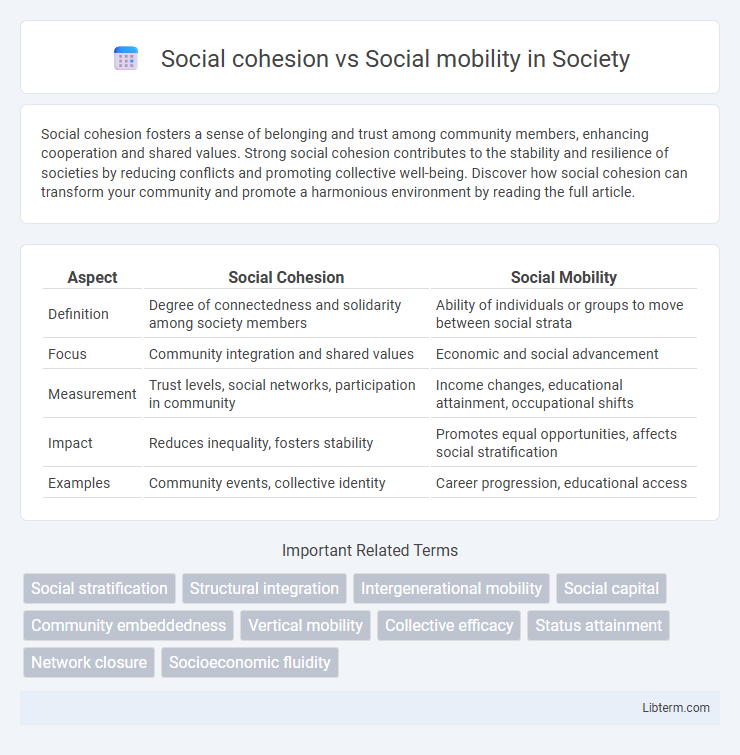Social cohesion fosters a sense of belonging and trust among community members, enhancing cooperation and shared values. Strong social cohesion contributes to the stability and resilience of societies by reducing conflicts and promoting collective well-being. Discover how social cohesion can transform your community and promote a harmonious environment by reading the full article.
Table of Comparison
| Aspect | Social Cohesion | Social Mobility |
|---|---|---|
| Definition | Degree of connectedness and solidarity among society members | Ability of individuals or groups to move between social strata |
| Focus | Community integration and shared values | Economic and social advancement |
| Measurement | Trust levels, social networks, participation in community | Income changes, educational attainment, occupational shifts |
| Impact | Reduces inequality, fosters stability | Promotes equal opportunities, affects social stratification |
| Examples | Community events, collective identity | Career progression, educational access |
Understanding Social Cohesion: Definition and Significance
Social cohesion refers to the strength of relationships and the sense of solidarity among members of a community, which fosters trust, cooperation, and shared values. It plays a crucial role in creating stable societies by promoting social inclusion, reducing inequalities, and enhancing collective well-being. Understanding social cohesion is essential for policymakers to develop strategies that support community resilience and sustainable development.
What is Social Mobility? Key Concepts Explained
Social mobility refers to the ability of individuals or groups to move within a social hierarchy, often measured by changes in income, education, or occupation across generations. Key concepts include intergenerational mobility, which assesses how social status changes from parents to children, and intragenerational mobility, which tracks shifts within an individual's lifetime. Understanding social mobility involves examining barriers like economic inequality, access to quality education, and systemic discrimination that influence opportunities for upward movement.
The Interplay between Social Cohesion and Social Mobility
Social cohesion strengthens community bonds by promoting trust, shared values, and cooperation, which can facilitate social mobility through supportive networks and collective resources. Conversely, increased social mobility can challenge social cohesion by creating disparities in status, identity, and economic opportunities that may fragment communal solidarity. Understanding the bidirectional relationship between these concepts is crucial for designing policies that balance equality of opportunity with social stability.
Historical Perspectives on Social Cohesion and Mobility
Historical perspectives on social cohesion reveal how shared values, traditions, and collective identities fostered stability within communities, particularly in agrarian and early industrial societies where rigid class structures limited social mobility. Social mobility, contrastingly, evolved as a concept during the rise of industrialization and modernization, emphasizing opportunities for individuals to change their socioeconomic status through education, employment, or migration. The tension between social cohesion and social mobility highlights the balance between maintaining societal order and enabling individual advancement throughout history.
Impacts of High Social Cohesion on Social Mobility
High social cohesion fosters trust, cooperation, and shared values within communities, which can create supportive environments for social mobility by providing networks, resources, and collective efficacy. However, excessive cohesion may also lead to exclusivity and social closure, limiting opportunities for outsiders and reinforcing existing social hierarchies. Balancing strong social bonds with openness is crucial to ensure high social cohesion promotes rather than hinders upward mobility.
Challenges to Achieving Social Mobility within Cohesive Societies
Achieving social mobility within cohesive societies faces challenges such as entrenched social norms and inequalities that limit access to education and economic opportunities for marginalized groups. Structural barriers like discrimination, unequal resource distribution, and limited social networks hinder upward mobility despite strong social bonds. Addressing these issues requires targeted policies that balance social cohesion with inclusivity and equal opportunity frameworks.
Policy Initiatives: Balancing Cohesion and Mobility
Policy initiatives aimed at balancing social cohesion and social mobility focus on creating inclusive systems that reduce inequality while promoting opportunities for upward movement. Investments in affordable education, equitable healthcare, and targeted social welfare programs enhance cohesion by supporting vulnerable populations and encourage mobility by enabling skill development and economic participation. Effective policies combine redistributive measures with incentives for innovation and employment to foster a resilient society that values both unity and individual progress.
Case Studies: Global Examples of Cohesion and Mobility Dynamics
Case studies from Nordic countries reveal strong social cohesion supported by comprehensive welfare systems, promoting equality and reducing disparities. In contrast, the United States exemplifies high social mobility potential but faces significant challenges to cohesion due to income inequality and segmented social structures. Brazil illustrates a mixed scenario with rapid social mobility in urban centers yet persistent regional inequality undermining national cohesion.
Social Cohesion vs Social Mobility: Benefits and Drawbacks
Social cohesion fosters community stability and shared values, promoting trust and collective well-being, but may limit individual opportunities for upward mobility. Social mobility enables individuals to improve their socioeconomic status through education and employment, enhancing economic dynamism while potentially weakening community bonds. Balancing social cohesion and social mobility is essential to achieving both societal harmony and personal progress.
Future Outlook: Harmonizing Social Cohesion and Mobility
Future outlooks emphasize harmonizing social cohesion and social mobility by fostering inclusive policies that reduce inequality while promoting opportunities for upward movement. Integrating community-based programs with education and employment reforms can strengthen social bonds and ensure fair access to resources. Targeted investments in diverse urban and rural areas aim to create resilient societies where social cohesion supports sustainable social mobility.
Social cohesion Infographic

 libterm.com
libterm.com